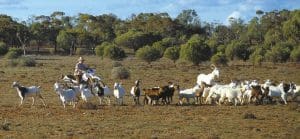
Rangeland goats being mustered in NSW. Photo – NSW DPI.
SIGNIFICANT improvements to the profitability and productivity of the NSW goat industry were possible and a priority, according to the NSW Department of Primary Industries.
NSW DPI has put rangeland goats in the spotlight with a position paper identifying the industry as an ongoing growth area, while recognising the unmanaged goat population is threatening the long-term sustainability of the rangeland production system.
NSW DPI manager data insights, Michael Rollin said NSW carried the largest population of rangeland goats in Australia, and significant improvements to the profitability and productivity of the industry were possible.
“In the DPI’s review of the Goat Industry Council of Australia (GICA) Goatmeat and Livestock Industry Strategic Plan 2020, we identified a number of areas in which we can collaborate with industry to help achieve the goals it sets out.”
DPI said the general position paper, ‘Development of the goat industry in NSW,’ highlighted the importance of increased collaboration and partnership between stakeholders, research and development in areas that focus on improving productivity and profitability, and market access and management of Total Grazing Pressure through the commercial harvesting of rangeland goats.
The position paper estimated the NSW farm gate value of the rangeland goat industry to be $102 million for 2016, despite many of the goats supplied in NSW being processed interstate.
However, the paper said construction is underway on a major goat abattoir located in Bourke in the rangelands of western NSW. The abattoir is expected to be operational in 2018 and it is estimated it would employ 200 people and process up to 6000 livestock per day (goats, sheep or lambs) for export. This has the potential to significantly increase the reportable value of the goat industry for NSW, the paper said.
“The new abattoir planned for Bourke will greatly assist as it will provide a closer processing facility to goat enterprises, and so reduce transport costs,” Mr Rollin said.
Demand for goat meat has been strong over the past four years, with prices reaching a record high of 683c/kg in July 2017 before easing to between 460c/kg and 490c/kg.
Mr Rollin believes the continuing export opportunities for goat meat in the United States, Taiwan and South Korea offer great scope for expansion.
“While NSW is the largest rangeland goat producing state in Australia, our export earnings from live goat and goat meat was only 2 percent of the national total in 2016-17,” he said.
Unmanaged goat population presents problems
The position paper recognised that commercial use of rangeland goats can also contribute to an improvement in resource conditions and conservation objectives because of reduced total grazing pressure, if mixed livestock diversification is undertaken.
“However, like many maturing industries, the goat industry has had periods of varying productivity and profitability, seasonal fluctuations in supply, and limited reliable information on the costs and benefits of production, processing and marketing.
“The unmanaged goat population in the NSW rangelands is also threatening the long-term sustainability of the rangeland production system.”
Goat industry profit and productivity improvement are priorities
The position paper concluded that while the NSW goat industry is relatively small in size, it has significant regional importance to the rangelands of NSW, and is also well-placed to grow.
“The delivery of reliable information from production through to marketing will help the industry to grow.
“The NSW government is prepared to assist in the development of a joint vision for the industry to 2020 and identify collaborative ways for the industry to achieve its strategic goals,” the paper said.
“Given NSW’s status as the largest producer of rangeland goats in Australia, improvements to the profitability and productivity of the industry are a priority.
“NSW DPI is currently engaged in a range of activities to develop the goat industry. Improving the collaborative culture within the industry is an area of particular importance for NSW DPI.”
Click here to read and download the general position paper – Development of the goat industry in NSW.
Source: NSW DPI.

HAVE YOUR SAY